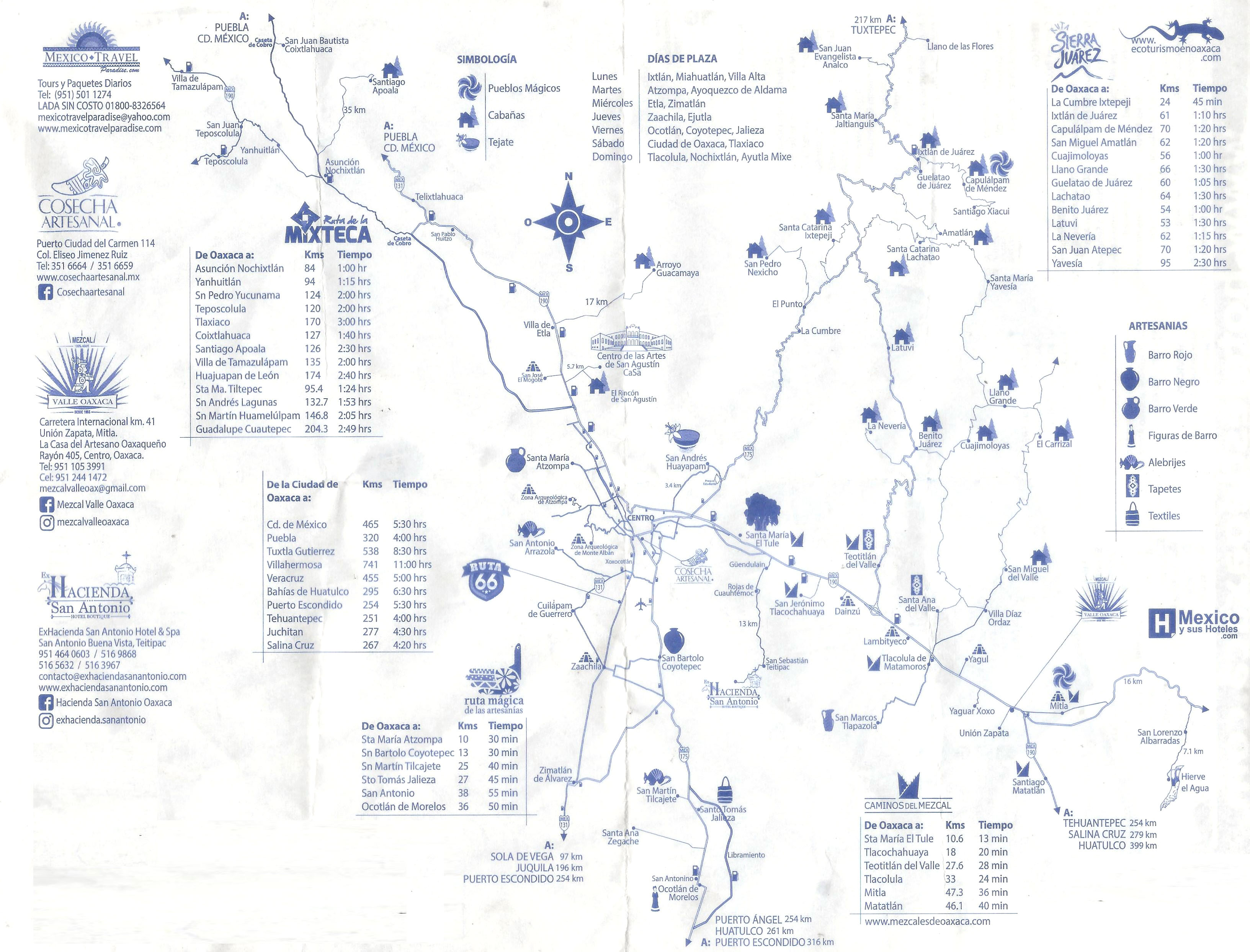Oaxaca City in the Centro District in the Central Valleys region of the state. Heritage and cultural tourism makes up an important part of the city’s economy, and it has numerous colonial-era structures as well as significant archeological sites and elements of the continuing native Zapotec and Mixtec cultures.
It is the site of the month-long cultural festival called the “Guelaguetza”, which features Oaxacan dance from the seven regions, music, and a beauty pageant for indigenous women.
The city is also known as “la Verde Antequera” and the variety of structures built from a native green stone. The name Oaxaca is derived from the Nahuatl name for the place, Huaxyacac, which was Hispanicized to Guajaca, later spelled Oaxaca. In 1872, “de Juárez” was added in honor of Benito Juárez, a native of this state who became president, serving from 1852 to 1872.
The Plaza de la Constitución, or Zócalo, was planned out in 1529 by Juan Peláez de Berrio. During the entire colonial period this plaza was never paved, nor had sidewalks, only a marble fountain that was placed here in 1739. This was removed in 1857 to put in the bandstand and trees were planted. In 1881, the vegetation here was rearranged and in 1885, a statue of Benito Juárez was added. It was remodeled again in 1901 and a new Art Nouveau bandstand installed. Fountains of green stone with capricious figures were installed in 1967. The bandstand in the center hosts the State Musical Band, La Marimba and other groups
Monte Albán, an ancient Zapotec capital in Oaxaca, Mexico, features grand pyramids, tombs, and observatories atop a mountain ridge, offering sweeping views and deep insights into Mesoamerican civilization.
Museo De Arte Contemporaneo De Oaxaca
is housed in the so-called Casa de Cortés. It is one of the oldest buildings in the city and one of the most representative of non-religious buildings. Although it has been modified somewhat over the years, it still conserves its basic layout with rooms surrounding three courtyards. The architectural style is basically Andalucian modified by Oaxaca traditions. The main portal is Spanish Baroque and has three levels. In the first, there are two “tritóstila” columns that support the balcony which has wrought iron railings. At the top of the window is seal of the Jesuits. The third level contains a central niche with a sculpture of an archangel as well as the coats of arms of the Laso de la Vega and the Pinelo families.
The architectural style is basically Andalucian modified by Oaxaca traditions. The main portal is Spanish Baroque and has three levels. In the first, there are two “tritóstila” columns that support the balcony which has wrought iron railings. At the top of the window is seal of the Jesuits. The third level contains a central niche with a sculpture of an archangel as well as the coats of arms of the Laso de la Vega and the Pinelo families.

Mercado Benito Juárez is located one block south of the Zócalo on Flores Magón and Las Casas but it takes up the entire city block
OAXACA City Map & Regional Map


Narrow streets are paved with stones extracted from the nearby mountains
One of the local culinary hot spots RESTAURANT “LAS QUINCE LETRAS”

Serene setting in the inner courtyard

Delectable and affordable dishes

And the Favorite “Bichos al Plato III”

SEVEN STYLES OF MOLE
Mole from Nahuatl mōlli, “sauce” is a traditional marinade and sauce originally used in Mexican cuisine. |
In contemporary Mexico the term is used for a number of sauces – see below

1. MOLE NEGRO
The “typical” savory-sweet mole mentioned above, and the one most frequently found.onion, garlic, whole spices like cinnamon, cloves, black pepper and cumin, dried chiles, pumpkin and sesame seeds, herbs like hoja santo (which contributes to the dark color) and cilantro, bread for thickening and sometimes dried fruit for extra sweetness.

2. MOLE ROJO
Red mole, also known as mole poblano, using many of the same spices and base ingredients and also contains chocolate, but less. Instead, this sweeter, spicier and versatile version is amped up with several kinds of dried red chile like pasilla, guajillo and ancho as well as pulverized raisins and almonds or peanuts. When the sauce is done, browned chicken, pork or beef is typically added and stewed until tender .

3. MOLE COLORADITO
This brew translates to “a shade of red,” or “on the nifty side,” depending on what you’re doing in the kitchen. Somewhere between rojo and negro in color, this brown mole shares the base ingredients of whole spices, onions, garlic, seeds and chocolate and features secret ingredients for thickening and sweetening: mashed ripe plantain.

4. MOLE AMARILLO
Picture all the goodness of the first three moles without the sweet and chocolate stuff and you have a delicious basic sauce to pour over or use as a cooking base It’s not unlike a simple Indian curry sauce, the sky’s the limit.
5. MOLE VERDE
White on the outside, green on the inside — that’s a pumpkin seed. Extra pepitas or pipian, along with fresh tomatillos, jalapenos and cilantro are the key ingredients in bright green mole verde. It can be diluted with chicken stock when it’s finished and poured over cooked chicken to make a soupy sauce mopped up with tortillas or bread.
6. MOLE CHICHILO
This one’s a little more intense. Round up all the beef bones y as you’re going to need them. This dark, spicy sauce starts with rich, homemade beef stock. The stock rehydrates dried chiles de arbol, anchos and guajillos which you then blend with the usual slow-cooked garlic and onions. Mole chichilo is thickened with either masa harina, lime-cured corn flour, or crushed fresh tortillas. No chocolate here but excellent for braises.
7. MOLE MANCHAMANTEL
This mole is between the bright red chorizo grease, tomatoes and ancho chiles, you do not want to get this stuff on anything white. Featuring fresh pineapple in addition to plantain, manchamantel is a sweet, spicy, fruity sauce . Hence the name – translated into “tablecloth-staining”

HOW TO MAKE MOLE AMARILLO
Mole amarillo (yellow mole) is a traditional Oaxacan dish known for its unique flavor profile, combining chilies, spices, and masa to create a vibrant yellow sauce. Here’s a detailed recipe to make mole amarillo:
Ingredients
For the Mole
- 4 dried guajillo chilies, seeds and stems removed
- 2 dried chilhuacle amarillo chilies, seeds and stems removed (or substitute with aji amarillo or yellow bell pepper if unavailable)
- 4 tomatillos, husked and washed
- 2 cloves garlic
- 1 small onion, quartered
- 1/2 teaspoon cumin seeds
- 1/2 teaspoon dried oregano
- 1/4 teaspoon ground cinnamon
- 1/4 teaspoon ground cloves
- 2 tablespoons masa harina (corn dough flour)
- 2 tablespoons vegetable oil
- 4 cups chicken or vegetable broth
- Salt to taste
For the Dish
- 1 lb chicken thighs or pork shoulder, cut into bite-sized pieces
- 2 medium potatoes, peeled and cubed
- 2 chayotes, peeled and cubed
- 1 zucchini, cubed
- 1 bunch green beans, trimmed and cut into 2-inch pieces
- 1 ear of corn, kernels removed
- Fresh cilantro for garnish
Instructions
Prepare the Mole Sauce
- Toast the Chilies:
- Heat a dry skillet over medium heat. Toast the guajillo and chilhuacle amarillo chilies until fragrant, about 1-2 minutes. Be careful not to burn them.
- Soak the Chilies:
- Place the toasted chilies in a bowl and cover with hot water. Let them soak for about 20 minutes until softened.
- Blend the Sauce:
- In a blender, combine the soaked chilies, tomatillos, garlic, onion, cumin seeds, oregano, cinnamon, cloves, and masa harina. Add 1 cup of the soaking water from the chilies and blend until smooth.
- Cook the Sauce:
- Heat the vegetable oil in a large pot over medium heat. Pour in the blended sauce and cook for about 10 minutes, stirring frequently.
- Add the chicken or vegetable broth gradually, stirring constantly. Bring to a simmer and let it cook for about 20-30 minutes, or until the sauce thickens. Season with salt to taste.
Prepare the Dish
- Cook the Meat:
- In a separate pot, cook the chicken or pork with a bit of salt until fully cooked. Remove and set aside.
- Cook the Vegetables:
- In the same pot used for the meat, add the potatoes, chayotes, zucchini, green beans, and corn. Add enough water to cover the vegetables and cook until tender but not mushy.
- Combine and Serve:
- Add the cooked meat to the pot with the vegetables.
- Pour the mole amarillo sauce over the meat and vegetables. Stir gently to combine and heat through.
- Serve hot, garnished with fresh cilantro.
Enjoy your mole Amarillo with warm tortillas ( blue corn if you can )
JOIN THE OCEAN POSSE WHICH FOCUSES ON FINDING INSPIRING DESTINATIONS FOR YOU AND YOUR VESSEL
SIGN UP FOR THE OCEAN POSSE











